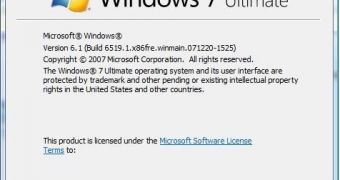Microsoft did officially confirm Windows 7's delivery in 2010, but additional details on the next version of the Windows operating system are scarce to say the least, as the project is built under the watchful eye of Steven Sinofsky, Senior Vice President, Windows and Windows Live Engineering Group. In 2007, one piece of information did manage to find its way from under the Windows Omerta, courtesy of Microsoft Distinguished Engineer Eric Traut - namely the Windows 7 MinWin core. Half a year later, and after Windows 7 M1, voices appeared claiming that MinWin would not make it into Windows 7.
Delivered as Milestone 1 build in January 2008, according to the leaked details, Windows 7 is making its way toward Milestone 2. Still, the successor of Windows Vista, offered not only to Microsoft's closest partners but also to antitrust regulators for review at the start of 2008, is still in its embryonic phase. As a matter of fact, Windows 7 M1 had to be deployed on top of Windows Vista Service Pack 1, and in this respect it was correlated with the RTM version of the service pack. In this context, Windows 7 offered just a taste of the next iteration of Windows, without bringing to the table a consistent evolution.
One of the most prominent aspects of the move from Vista to Windows 7, the MinWin core was not included into Milestone 1. The development milestone build of Windows 7 featured the same kernel as the latest Windows client, and little additional changes. No trace whatsoever of MinWin. Those familiar with the development process of new Windows platforms already know that the next-generation operating systems are initially very similar to their predecessors. It happened to the early builds of Longhorn (the Longhorn that ended up as Vista not Windows Server 2008) and to Windows XP, and it is happening to Vista and Windows 7. But this is not to say that Microsoft is not hammering away at MinWin.
Traut made one thing clear back in 2007, and the video fragment embedded at the bottom will offer proof of this. MinWin "is the core of Windows 7," he stated, after he explained that Windows 7 was indeed the successor of Windows Vista and praising Sinofsky for the brilliant product number choice instead of a codename. "It is a collection of components that we've taken out," Traut added. "At its core, the kernel and the components that make up the very core of the operating system, actually it's pretty streamlined. It's still bigger than I'd like it to be but we've taken a shot recently at really stripping out all of the layers above and making sure that we have a very clean architectural layer."
Where is the confusion? Well, basically there is a difference between Windows 7's kernel and the MinWin core. What is MinWin? It is actually the kernel of the operating system plus a sum of components that together can act as the smallest possible standalone version of Windows. It is not the actual kernel. Traut for example has cut many dependencies with the rest of the operating system, and especially the shell that MinWin was back in 2007 just 25 MB and running with only 40 MB RAM. MinWin is an internal project only, and Microsoft indeed has no plans of productizing it.
But no plans of productizing it in its current form, as a standalone product. Which would be rather impossible as MinWin is virtually bare-boned with no graphics subsystem and only a rudimentary HTTP server. But this does not mean that MinWin won't find its way into Windows 7, and into Microsoft's vision of a modularized Windows 7 platform spread among desktop and cloud components. The entire, hour-long, presentation of Eric Traut is available here.
Mark Russinovich, Microsoft Technical Fellow, explained: "The MinWin that we are talking about today is really [the work] done to analyze the dependencies and carve out the lowest, smallest, core component of Windows. A standalone, testable, slice of Windows. And that is analyzing the dependencies and cutting the lines, the cycles, from MinWin to higher level components, really making sure that MinWin doesn't depend on anything else. That is totally self-contained... so it can be built separately from the rest of Windows source tree and run independently from the Windows source tree. And it can run independently from the Windows source tree." Video Here.
Russinovich explains that MinWin is not the actual kernel of Windows 7, but the core of the platform running in kernel mode, along with additional components that also run in kernel mode. Basically, everything that's at the center of the system level components, not just the NTOS kernel, or the core of the NTOS kernel, for that matter. MinWin is actually the new core of Windows 7, including the kernel, adjacent components and even system level items.
Will MinWin be a radical overhauled core compared to what we can see today in Windows Vista and Windows Server 2008? No! Just as Microsoft needs not to break the web with Internet Explorer 8 vs. Internet Explorer 7, the same is valid for the desktop and the ecosystem of hardware and software products that rely on Windows. MinWin will not be a shift in the evolution of Windows kernel since Microsoft indeed does not afford to introduce incompatibility issues with the solutions designed to integrate with Windows today. But at the same time, it will strip down Windows and deliver MinWin in Windows 7.

 14 DAY TRIAL //
14 DAY TRIAL //